Compression Therapy and ABI Values – Flashcards
Unlock all answers in this set
Unlock answersquestion
Compression Physiology
answer
- Reduces diameter of veins, causing endothelial cells to become tighter therefore reducing fluid leakage from the veins - Produces increase in blood flow toward heart and reduces venous reflux
question
Compression Physiology The degree of compression is determined by:
answer
- Elasticity of bandage - Number of bandage layers - Shape and size of limb - Skill and technique of clinician - Nature of physical activity undertaken by patient
question
Laplace's Law

answer
Sub-bandage pressure is directly proportional to bandage tension but inversely proportional to the radius of the curvature of the limb to which it is applied
question
Increased bandage tension and increased # of bandage layers =
answer
Increased sub-bandage pressure
question
Increased leg circumference and increased bandage width =
answer
Decreased sub-bandage pressure
question
Bandage Types Long Stretch
answer
- Ace Wrap - Used for more aggressive compression
question
Bandage Types Short Stretch
answer
- Lymphedema bandages - Safer than long stretch due to less extensibility and therefore less tension to limb
question
Bandage Types Inelastic
answer
- Unna boot - Hardens after application like a cast, forming a rigid compression bandage
question
Resting Pressure vs. Working Pressure
answer
Resting Pressure: pressure bandage exerts on the tissues at rest Working Pressure: pressure bandage exerts against working musculature
question
Compression Precautions
answer
- DM (decreased sensation) - PVD/Arterial insufficiency - Acute cellulitis/infection - Neuropathy - Acute CHF - Low Ejection Fraction - Fragile Skin
question
How much compression is safe?
answer
ABI = 0.5 or less (NONE! Compression is CONTRAINDICATED) ABI = 0.6 - 0.8 (Modified compression can be applied, 20-30 mmHg) ABI = > 0.8 (Normal compression can be applied, 30-40 mmHg) ABI = > 1.3 (Unreliable due to calcification of vessels)
question
Compression Stockings are indicated for legs with:
answer
History of ulcers Edema or risk of edema Varicosities or spider veins History of DVTs History of cellulitis (NOT for legs with open wounds)
question
4 Classes of Compression Stockings
answer
15-20 mmHg 20-30 mmHg 30-40 mmHg (best for venous etiology) 40-50 mmHg (usually best for lymphedema)
question
How to instruct patients on compression stocking use
answer
Wear during waking hours, when out of bed Do not moisturize prior to applying, moisturize at night instead
question
Compression Alternatives
answer
- Inelastic adjustable compression garments, ie. CircAid, Farrow wrap - Flat-knit custom garments - Multi-layer compression stockings - Custom compression stockings - Intermittent pneumatic compression (IPC) pump
question
Patient Education on Compression Wraps and Stockings
answer
- Wound recalcitrance (high recurrent rate) - Elevation of LEs above heart when sitting or lying - No prolonged standing but encourage walking - Importance and purpose of wraps and stockings - Monitoring for changes such as CHF, cellulitis and vascular status



